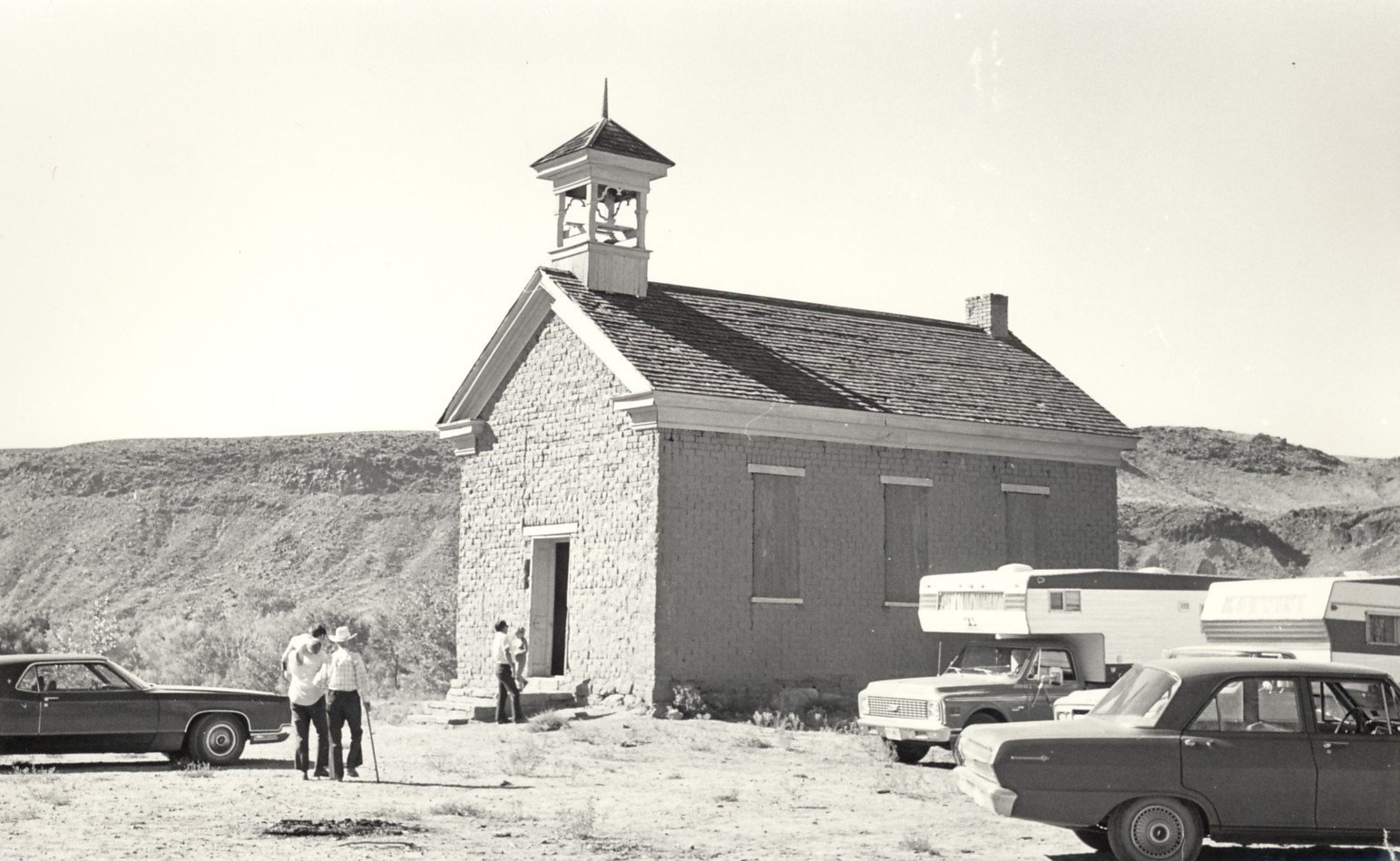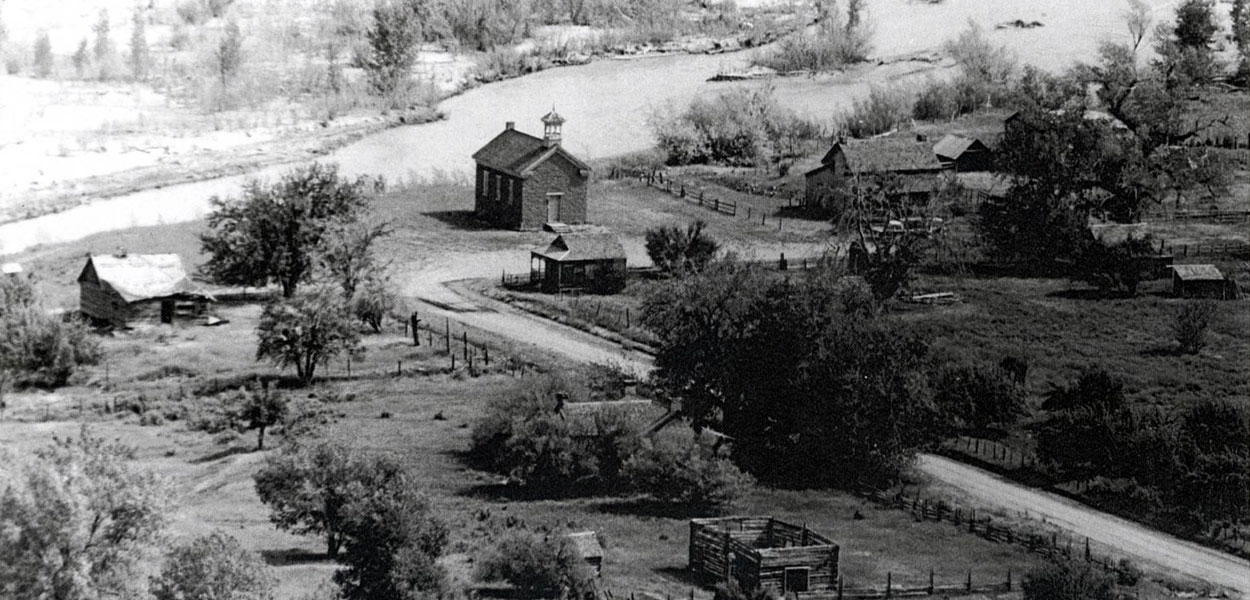
WASHINGTON COUNTY HISTORICAL SOCIETY (Washington County, Utah)
GRAFTON, UTAH
LOCATION
From Hwy. 9 in Rockville, Utah, turn south on Bridge Road (200 East). Bare right after crossing the Virgin River. Turn right again at the stop sign. The last 2.6 miles are unpaved but should be okay for cars in dry weather. Grafton's cemetery is on the left at a turn 0.3 mile before the town site.1900 map of Grafton.
Map of Grafton
HISTORY
Nathan C. Tenney and others from Virgin settled in Grafton in 1859. The fertile Virgin River valley provided opportunity for the early settlers to grow cotton. The town reached a population of 120 in 1900.The Grafton Ward was organized in 1877 and quickly outgrew the little log school house of 1862. The chapel was begun in 1886 and dedicated on July 8, 1888. The ward was demoted to a branch of the Rockville Ward in 1907. It was decommissioned altogether in 1921 and the chapel has not been used since that time.
Although the land was fertile, Indian raids and continuous flooding discouraged many. The town thrived for some time, but people began to move to safer places after 1900 and by 1921 Grafton had become a ghost town.
The town and its meeting house were featured in the 1930 film "The Arizona Kid" and more recently in "Butch Cassidy and the Sundance Kid".
Two efforts to preserve Grafton faltered while the town's buildings suffered serious deterioration and vandalism. Lu Wayne Wood, who was born in Grafton in 1911, initiated a new effort to stabilize the town's church/school in 1995. The adobe building was in imminent danger of collapse. From this focus on a single building, the project expanded to include the entire town site. The need for action was urgent as pressure was growing from developers who wanted to purchase the land surrounding Grafton and construct condominiums.
The Grand Canyon Trust joined the partnership to support the preservation of the fragile Virgin River riparian environment. The Trust took on significant fundraising for the project as well as scientific analysis of the site. David Hatfield, mayor of the nearby town of Rockville, accepted the chairmanship of the partnership. His patient leadership helped the ideologically diverse members of the partnership reach successful compromises.
The Grafton Heritage Partnership's achievements are many. It has sensitively renovated the historic church/school and secured commitments from the private landowners in the townsite to keep their land in agricultural use. It also raised $1,350,000 to purchase the 220-acre Stout Ranch that surrounds the townsite to prevent Grafton from being ringed by development.
The Grafton Heritage Partnership has continued working on the restoration and interpretation of the town site.
PHOTOS

WCHS-05483 Old Grafton looking northeast

WCHS-00370 Adobe meeting house in Grafton
WCHS photos:
WCHS-00555 Jon Bowcutt sketch of the Grafton Church
Other photos on the web:
Log house or barn at Grafton
The adobe meeting hall and house at Grafton
Photo of the adobe meeting hall at Grafton
Photo of some grave plots at the Grafton Cemetery
Photo of the Robert M. Berry headstone at the Grafton Cemetery
A collection of Grafton ghost town photos
REFERENCES
Historic Grafton PamphletGrafton Heritage Partnership Project
Grafton historical features
Wikipedia article about Grafton
A history of Grafton
Historical Buildings of Washington County (Volume 1), pp. 32-33.
Commentary on Grafton by Mary Phoenix
Grafton Hertiage Partnership Project "Grafton News", Fall 2020
Grafton 1862-1944 structures and map
Washington County Chapter, Daughters of the Utah Pioneers, " Under Dixie Sun".
1950 with 1978 Supplement.
Page 119.
Grafton, Ghost Town on the Rio Virgin
Book by Lyman & Karen Platt
1998, 200 pp.
Historic Rockville, Utah
Book by Jane E. Whalen, 2012.
Pages 110-115: "1862-1945 Grafton Historic District"
Pages 116-117: "1862-1924 Grafton Cemetery"
James T. Jones, " Old Grafton, History of Grafton, Utah (1861-1921)"
In Their Honor: The Life Stories of Clara Marie Scott & Thomas Irving Stanworth
A book by their granddaughter, Linda (Stanworth) Dinkel
Lyman & Karen Platt
Grafton, Ghost Town on the Rio Virgin
200 page book originally published in 1998 and later reprinted by the the Grafton Heritage Partnership
Dr. Lyman D. Platt, "Grafton: Ghost Town on the Rio Virgin".
St. George: St. George Magazine, 1998. 200 p.
Victor Hall, "Life in Grafton"
This article is based on accounts by Grace Atkin Woodbury and Bertha Wood Hall.
Grafton 'Rides' Again: Utah's most famous ghost time gets a new lease on life
Article by Reuben Wadsworth, Salt Lake Magazine, pp. 80-82
Utah Heritage Award presented to the Grafton Heritage Partnership on October 19, 2000.
Grafton Field Trip Notes
Handout at the 4/22/2023 WCHS Field Trip
By Richard R. Kohler, April 22, 2023